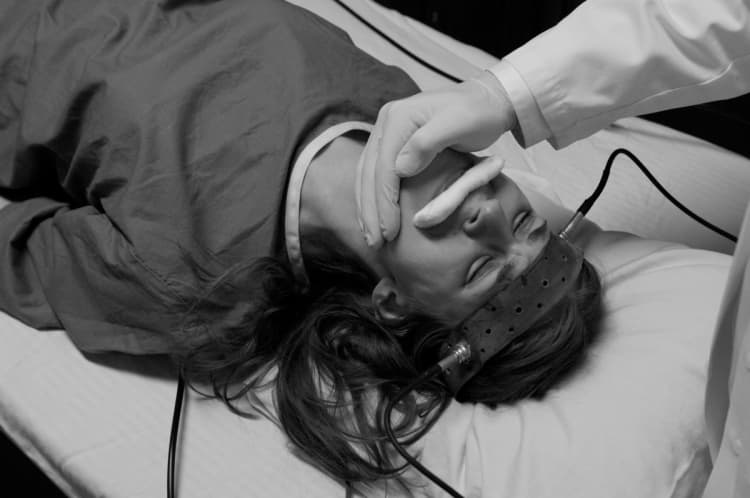It doesn’t feel like anything. You’re unconscious while the procedure is being carried out. The end. (Just kidding).
Hello everyone, my name is Darren Toh, and I suffer from Treatment Resistant Major Depressive Disorder (or more commonly known as Severe Depression).
I've been invited by Human to write about my experience living with severe depression. Today, I’ll be writing about Electroconvulsive Therapy (ECT, also known as Electroshock Therapy).
Electroconvulsive Therapy is a procedure where a small current is passed through a person’s brain while unconscious. This triggers a brief seizure, which often results in the patient quickly recovering from their mental illness.
ECT has a rich and insanely (haha get it?) interesting history. While it was once carried out without much regard for patient comfort and well-being, in the modern day, ECT is a safe and painless procedure. Take it from someone who's done it 30 plus times.
What's it like living with severe depression?
Let me begin by providing some context. Due to the debilitating nature of my illness, I often sob in public, on the MRT, in class, at Starbucks, before I sleep, when I wake up; I just can’t control my emotions, and it feels miserable all the time.
Medications do very little for me. After several hospitalisations and suicide attempts, my alienist (an old term for psychiatrist, haha) suggested that I have a go with Electroconvulsive Therapy.
There's a very negative connotation attached to ECT. I know this from fellow patients I've spoken to, and just from observing society as a whole.
Unfortunately, the very same people who could have benefited most from ECT, were also the most averse to it. In particular, they were so worried about personality changes, getting their brain damaged, or having their memories wiped, that they couldn't take an objective view about the treatment.
I felt so sad for these patients, because they had to continue living with the severe pain of depression.
Checking in for Electroconvulsive Therapy at IMH

Unlike other patients, I was excited to do ECT. I guess this is where I differ from others. I love novel experiences. I’m eccentric like that.
At IMH, I go up to the main counter and speak to the nurse present. I inform them that I'm here for ECT.
After getting my blood pressure and oxygen levels taken, I'm led to the room where ECT is carried out.
This room is separated into two areas: the waiting and recovery area, and the other where the actual procedure is carried out.
I'm given a gurney to lie on while waiting, and my blood pressure and oxygen levels are taken once again. The nurses strike up a conversation with me, asking me how I've been. They are so nice.
I use my phone while waiting for my turn, and after about 15 minutes, I'm wheeled into the treatment room.
Meeting the Electroconvulsive Therapy team
A team of nurses (about 5), 3 medical students, a psychiatrist and an anaesthetist are present.
The psychiatrist reviews my case notes, and asks me how I am. I ask jokingly if I can begin to start screaming to scare the students. He tells me not to.
The anaesthetist is teaching the students. His job is to ensure I'm okay during the procedure, and to "wake me up" once it's over.
My nurses busy themselves attaching leads onto my head for the Electroencephalogram (EEG), and onto my chest for the Electrocardiogram (ECG).
The EEG is used to measure my brain activity, and the ECG is used to measure my heart activity. A blood pressure monitor, as well as an oxygen saturation monitor are also swiftly attached.
Shit gets real

All of this monitoring is necessary, as I'll be completely unconscious during the procedure.
I'm required to fast for 6 hours before the procedure to prevent aspirating liquids into my lungs.
A cannula (tiny plastic tube) is placed into one of my arm veins. This is how Propofol, the drug used to induce unconsciousness will be introduced into my body.
A bell is rung, and my details are read out. I begin to tear up as I'm starting to feel awful (due to my depression), and a nurse holds my hand to comfort me.
The Propofol is slowly injected, followed by a muscle relaxant (Suxamethonium). The muscle relaxant ensures I do not thrash about while having the seizure. This also protects me from the other side effects of having a seizure (muscle cramps, broken bones etc).
Something tastes metallic, which I find so strange because I didn’t have anything on my tongue. I murmur “good night” to the team, as I feel the Propofol taking over my body.
Lights out

My eyes close and I try to speak, but I cannot (I was testing my ability to, rather than trying to tell the team something). I try to form a thought, but I cannot. It's one of the weirdest experiences ever.
My brain feels like it's going to explode (this is because the Suxamethonium causes head contractions).
After about 5 seconds, I'm unconscious. A mouth guard is placed into my mouth to prevent me from biting my tongue, and the procedure is carried out.
An electric current is passed through my brain. The strength of the current is titrated to maximize the therapeutic benefits, while minimizing side effects.
While inducing a long seizure will result in more therapeutic effects, it also results in worse headaches, muscle cramps, and pain after the procedure.
I must say at this point that the physical pain of ECT is extremely mild, compared to the EXCRUCIATING PAIN of depression. This is why I've given consent to undergo ECT treatment the past thirty times.
The aftermath of Electroconvulsive Therapy
I'm wheeled out of the room to the recovery area once my seizure has ended.
I wake about 10 - 15 minutes later, thoroughly disorientated and confused. It takes me a full 3 minutes to get a grasp of where I am, and I've got this terrible splitting headache.
The nurses ask me "reorientation" questions, such as "What date is it?", "Where am I?", and "Who's the former prime minister of Singapore".
I'm given biscuits and a Milo when I'm properly "back to earth" about 15 minutes later. I also pop a (self-medicated) Panadol and Caffeine pill to recover quicker from the Propofol.
The nurses watch over me in the recovery room for two hours before I'm allowed to go home. And that's it.
The truth is that I've heard many varying accounts of patients going through ECT, but my view is that many often dramatize their experiences. I don't understand why.
Final words
You might be interested to know how I'm doing today, after undergoing so much ECT.
Well, I definitely have memory loss of certain events in the past, but it's terribly trivial in comparison to finally getting my depression in check after so many years.
I didn't receive any brain damage for sure. If anything, I feel more intelligent as I’m no longer consumed by sadness, and thus I'm better able to process cognitive matters. I also no longer self-harm, nor do I feel absolute perpetual misery. Can you imagine preparing for A Levels, while sobbing profusely? That was my life for so long.
ECT has definitely reduced my suffering immensely, as has the team of doctors and nurses looking after me at IMH.
To conclude, please note that this is a personal recount, and might not be representative of what any individual might experience.
I'm also not a medical professional, so I don't know the exact details and nuances of the procedure. If you have any questions about ECT, or mental health-related issues in general, do direct them to the qualified doctors and psychiatrists on Human.
What I hope to accomplish is to provide an accurate and detailed account of my experience, in the hopes that Singaporeans will become more comfortable with depression and related treatments.
Mental health patients are just like you too, and not any less of a person; please treat them like how you would any others.
It's common in Singapore to dehumanise the mentally ill, which results in ostracising and stigmatisation. This makes the suffering hurt even more, and is something I hope I can change within my lifetime.
Darren Toh is a Human guest writer, and a former professional League of Legends player who was once the best in South East Asia. He has retired and is currently studying to get into university. He is an oddball who dares to tread where no one else does. He hates the smell of silicone.
